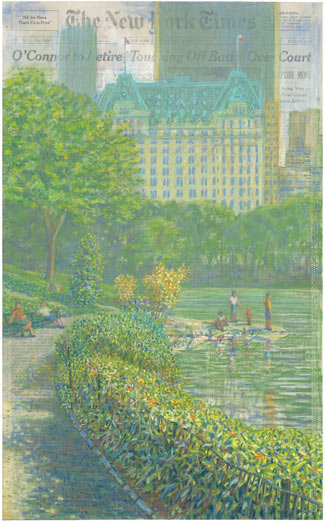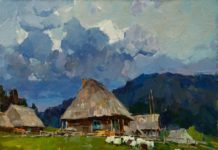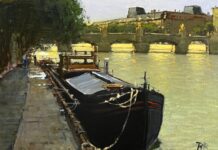Tom Matt doesn’t live near his favorite place to paint anymore, but one innovative technique he developed there lives on in his work.
Matt loved painting New York City. He lived there 15 years before moving to Kansas City two years ago. When he was there, he discovered that the only way he could feel truly excited about a painting was if he found a powerful scene and figured out the best vantage point for viewing it.
“I’d see people painting and I’d ask myself, what is it that they are responding to, and why?” says Matt. “They would set up in front of restaurants and paint facades, and I would shake my head. Did they exhaust all their options for the quintessential view? I find that I need to take time to look for a vantage point that is very challenging and exciting. Before I make a mark, I spend a lot of time walking around and looking. In New York City I would rollerblade all over and see views and look at all the different angles. I’d visit a place on an overcast day, a sunny day. I’d go through the hard work of editing and making thumbnail sketches of views in my head. Which one really excites me? That was the criterion — I only decided to do something if it really excited me. I had the same idea when I was dating. If it not’s going to work, don’t settle. But if I found the right view, and it was exciting, I had the inspiration to carry through.”
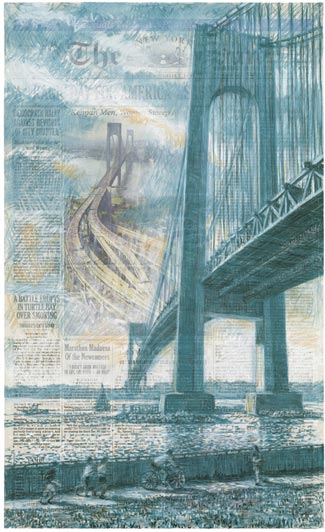
“The Verrazano Bridge,” by Tom Matt, pastel on newspaper, 18 1/2 x 12 1/3 in.
But even when Matt found just the right angle to capture something as imposing as the Verrazano-Narrows Bridge, it was not enough. The bridge might suggest the considerable infrastructure of New York City, the thousands who use it each day, and the scores of skilled people who built it, but there are 8 million stories in the naked city. Matt needed to find a way to communicate all the activity that surrounds and infuses his views of New York.
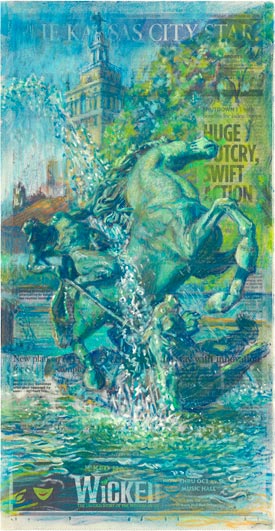
“J.C. Nichols II,” by Tom Matt, pastel on newspaper, 21 x 11 in. Collection of Mike Lewer
His solution was to use the pages of daily newspapers as his substrate. “It added a new dimension to a piece,” says Matt. “Working on newspaper added a level of what the city was. A picture of the city is not only the view but the people and the news and the stories behind the facades of things. Life is layered and interesting. My work on newspapers spoke to that. It’s about time, the date on the newspaper; in a way, I put my mark on the mark of history.”
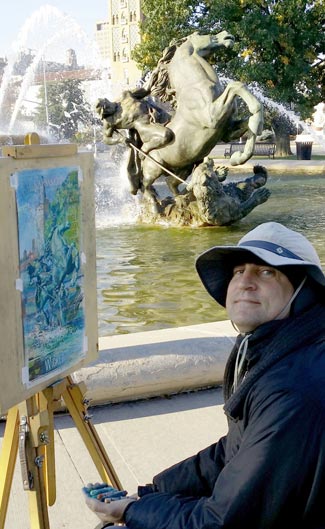
Matt at work on location
Obviously, newspapers yellow and degrade very quickly. Matt’s pieces can sell for thousands of dollars, so how does he guarantee that they are archivally sound? He doesn’t. “The concept was so strong in the beginning that it had value and made it worth it,” says Matt. “The people who buy the pieces on newspaper understand that it is not necessarily archival. In some cases I have made prints to give it some longevity. In the beginning, I just had never seen this process done before, and I found it poetic. I wish it were more archival, but it is what it is. I guess in some ways you could say it takes on the characteristics of an installation, an installation that is not meant to last.”
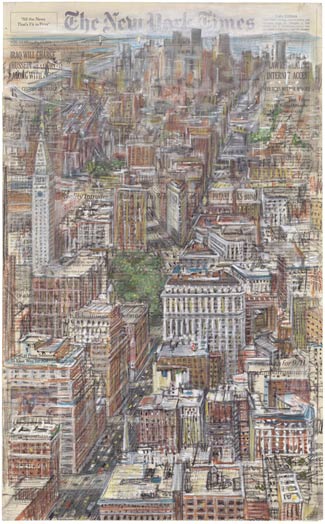
“Lower Manhattan From the Empire State Building,” by Tom Matt, pastel on newspaper, 22 x 13 in.
The term “installation” can imply an event more than an artifact, and that dovetails well with Matt’s thinking when painting a piece on newspaper. Once he finds a location and a suitably inspiring view, the artist thinks about when he will have time to tackle the painting. On that day, he buys newspapers and finds a way to use the images and text to enhance the composition. He paints on the front page with pastels, and sprays it with fixative when done. Although he sometimes must rely on reference photos to finish a piece, Matt feels strongly that executing the piece en plein air produces a superior experience. “Once I find a view, it is done, in a way,” says the artist. “It is finished; it was already done in my mind. I just have to do it. I try to finish it quickly — I don’t use last week’s newspaper. I do it the day of.
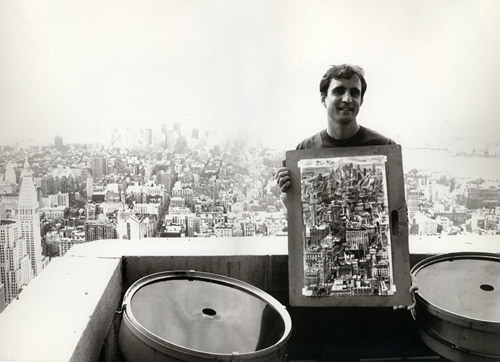
Matt at work at the top of the Empire State Building
“I like working on them on location because it is an experiential thing. I take a photo reference in case it rains a lot or other conditions occur that would prohibit me from working outside. But most of the time the weather is fine and I work around it. It’s about being in the world, experiencing what’s going on around me as a human being in the world. It’s about the sound of the city or of nature, being around the elements, being able to use my eyes and see what is it about the view that is inspiring. It’s fun to go out and explore. It gets me out.”
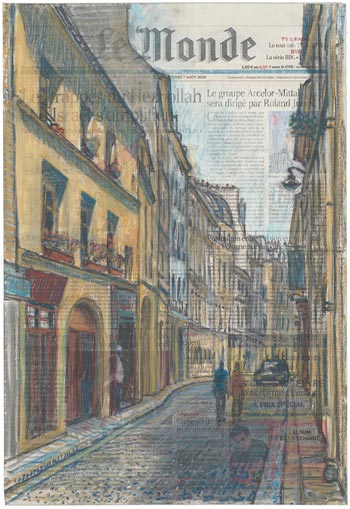
“Rue des Grands Augustins,” by Tom Matt, pastel on newspaper, 18 1/2 x 12 1/2 in.
Matt developed the approach in New York, but he has used it in Paris and in Kansas City. He says he feels like it worked best in the Big Apple. Maybe it’s because New York City was his home, an area he explored extensively. Maybe it’s the nature of the city. “In New York, I was standing in the middle of a still life,” he says.

